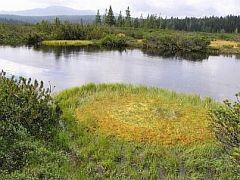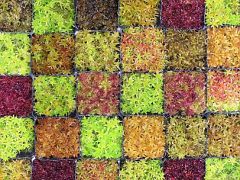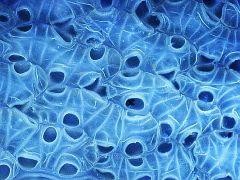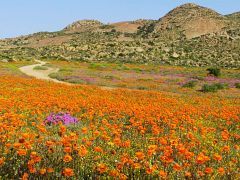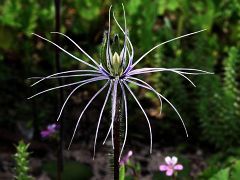
Personal Page of Tomáš Hájek
University of South Bohemia > Faculty of Science > Dpt. of Experimental Plant Biology
Branišovská 1760, CZ-370 05 České Budějovice, Czechia
(tel.: +420 387 772 342) GSM: +420 608 327 216
e-mail: 
About Me
I am a plant ecologist/physiologist at the University of South Bohemia, Faculty of Science and at the Institute of Botany of AS CR, Plant Ecology Section in Třeboň.
My main research activity is focused on ecology and ecophysiology of peat mosses (Sphagnum): stress ecophysiology, mineral nutrition, desiccation (in)tolerance, photosynthesis, decomposition & litter quality, etc. Other research activities include peatland ecology in general and various aspects of plant ecophysiology, in particular plant water relations.
CV
| Born: | 1976 |
| Education: | |
| • 1996–1999: | Bachelor degree, Faculty of Biological Sciences, University of South Bohemia Thesis: Surface temperatures in a bog and their modeling. |
| • 1999–2002: | Master degree in Botany, at the same place Thesis: Sphagnum production and decomposition on a mountain raised bog. |
| • 2002–2008: | PhD. degree in Ecology, Faculty of Science, University of South Bohemia Thesis: Ecophysiological adaptations of coexisting Sphagnum mosses. |
| Positions: | |
|---|---|
| • 2003–now: | Institute of Botany, Academy of Sciences of the Czech Republic |
| • 2005–now: | Department of Experimental Plant Biology, Faculty of Science, Univ. South Bohemia |
| Teaching at Faculty of Science: | |
| • Basic course of plant physiology | |
| • Plant physiology (water relations, excersizes) | |
ORCID: 0000-0002-5981-5840 | |
| Scopus profile: 35299255500 | |
Research Activities
Publications
2025
Lehejček J., Huseynli A., Luláková P., Křížová P., Hájek T., Němeček K., Drábek O., Valášek P., Valášek P.JR & Tejnecký V. (2025): Plant–soil interactions in a deglaciated landscape: roots reflect environmental severity. Scandinavian Journal of Forest Research. DOI: 10.1080/02827581.2025.2563598.
Lillipuu E.M., Májeková M., Dvorský M., Liancourt P., Hájek T. & Mudrák O. (2025): Drought avoidance strategy drives the assembly of plant communities in grasslands restored on former arable land. Journal of Environmental Management 386: 125844. DOI: 10.1016/j.jenvman.2025.125844.
Procházková J., Hájek T., Mikulášková E., Plášek V., Těšitel J. & Hájek M. (2025): Congruent responses of epiphytic bryophyte communities to air pollution on two host tree species differing in bark chemistry. Preslia 97: 157–173. DOI: 10.23855/preslia.2025.157.
Tejnecký V., Luláková P., Šantrůčková H., Křížová P., Lehejček J., Hájek T., Mercl F., Bárta J., Němeček K. & Drábek O. (2025): Arctic willow (Salix polaris) exudation as a driver of microbial activity and soil formation in the High Arctic tundra. Biogeochemistry 168: 30. DOI: 10.1007/s10533-025-01222-x.
Segrestin J., Lisner A., Götzenberger L., Hájek T., Janíková E., Jílková V., Konečná M., Švancárová T. & Lepš J. (2025): Biodiversity loss disrupts seasonal carbon dynamics in a species-rich temperate grassland. Ecology 106: ECY70091. DOI: 10.1002/ecy.7009.
Hamzé M., Choël M., Vandenbossche K., Gosselin S., Farah J., Monnier S., Hájek T. & Visez N. (2025): Counting sedimented Betula pollen grains by gas chromatography coupled with mass spectrometry. Aerobiologia. DOI: 10.1007/s10453-025-09855-z.
2024
Hájek T., Urbanová Z. (2024): Enzyme adaptation in Sphagnum peatlands questions the significance of dissolved organic matter in enzyme inhibition. Science of The Total Environment 911: 168685. DOI: 10.1016/j.scitotenv.2023.168685.
Weides S., Hájek T., Liancourt P., Herberich M. M., Kramp R. E., Tomiolo S., Tielbörger K. & Májeková M. (2024): Belowground niche partitioning is maintained under extreme drought. Ecology 105: e4198. DOI: 10.1002/ecy.4198.
Ravolainen, V., Paulsen, I. M. G., Eischeid, I., Forbey, J. S., Fuglei, E., Hájek, T., Hansen, B. B., Loe, L. E., Macek, P., Madsen, J., Soininen, E. M., Speed, J. D. M., Stien, A., Tømmervik, H., & Pedersen, Å. Ø. (2024): Low spatial habitat overlap of herbivores in the High Arctic tundra. Global Ecology and Conservation 49: e02797. DOI: 10.1016/j.gecco.2024.e02797.
2023
Awasthi P., Mishra A.K., Kocábek T., Sukumari Nath V., Mishra S., Hazzouri K.M., Sudalaimuthuasari N., Stajner N., Jakše J., Krofta K., Hájek T., Amiri K.M.A. (2023): CRISPR/Cas9-mediated mutagenesis of the mediator complex subunits MED5a and MED5b genes impaired secondary metabolite accumulation in hop (Humulus lupulus) Plant Physiology and Biochemistry 201: 107851. DOI: 10.1016/j.plaphy.2023.107851.
Visez N., Hamzé M., Vandenbossche K., Occelli F., de Nadai P., Tobon Y., Hájek T. & Choël Marie (2023): Uptake of ozone by allergenic pollen grains. Environmental Pollution 331: 121793. DOI: 10.1016/j.envpol.2023.121793.
2022
Kosová V., Hájek T., Hadincová V. & Münzbergová Z. (2022): The importance of ecophysiological traits in response of Festuca rubra to changing climate. Physiologia Plantarum 174: e13608. DOI: 10.1111/ppl.13608.
2021
Martínková J., Hájek T., Adamec L. & Klimešová J. (2021): Growth, root respiration and photosynthesis of a root-sprouting short-lived herb after severe biomass removal. Flora 284: 151915. DOI: 10.1016/j.flora.2021.151915.
Jílková V., Devetter M., Bryndová M., Hájek T., Kotas P., Luláková P., Meador T., Navrátilová D., Saccone P. & Macek P. (2021): Carbon sequestration related to soil physical and chemical properties in the high Arctic. Global Biogeochemical Cycles 35: e2020GB006877. DOI: 10.1029/2020GB006877.
Lubbe F.C., Bitomský M., Hájek T., de Bello F., Doležal F., Jandová V., Janeček Š., Bartušková A., Lanta V. & Klimešová J. (2021): A tale of two grasslands: how belowground storage organs coordinate their traits with water-use traits. Plant and Soil 465: 533–548. DOI: 10.1007/s11104-021-05031-7.
Angst G., Pokorný J., Mueller C.W., Prater I., Preusser S., Kandeler E., Meador T., Straková P., Hájek T., van Buiten G. & Angst Š. (2021): Soil texture affects the coupling of litter decomposition and soil organic matter formation. Soil Biology and Biochemistry 159: 108302. DOI: 10.1016/j.soilbio.2021.108302.
Urbanová Z. & Hájek T. (2021): Revisiting the concept of 'enzymic latch' on carbon in peatlands. Science of the Total Environment 779: 146384. DOI: 10.1016/j.scitotenv.2021.146384.
Májeková M., Hájek T., Albert A., de Bello F., Doležal J., Götzenberger L., Janeček Š., Lepš J., Liancourt P. & Mudrák O. (2021): Weak coordination between leaf drought tolerance and proxy traits in herbaceous plants. Functional Ecology 35: 1299–1311. DOI: 10.1111/1365-2435.13792.
Kubásek J., Hájek T., Duckett J., Pressel S. & Šantrůček J. (2021): Moss stomata do not respond to light and CO2 concentration but facilitate carbon uptake by sporophytes: a gas exchange, stomatal aperture and 13C labelling study. New Phytologist 230: 1815–1828. DOI: 10.1111/nph.17208.
Barrio I.C., Ehrich D., Soininen E.M., Ravolainen V.T., Bueno C.G. et al. (2021). Developing common protocols to measure tundra herbivory across spatial scales. Arctic Science8: 638–679. DOI: 10.1139/AS-2020-0020.
2020
Tveit A.T., Kiss A., Winkel M., Horn F., Hájek T., Svenning M.M., Wagner D., Liebner S. (2020). Environmental patterns of brown moss- and Sphagnum-associated microbial communities. Scientific Reports 10: 22412. DOI: 10.1038/s41598-020-79773-2.
Hájek T. (2020): Interlinking moss functional traits. A commentary on: ‘Water economy responses to water level drawdown in peat mosses’. Annals of Botany 126: iv–v. DOI: 10.1093/aob/mcaa108.
Vicherová E., Glinwood R., Hájek T., Šmilauer P. & Ninkovic V. (2020): Bryophytes can recognize their neighbours through volatile organic compounds. Scientific Reports 10: 7405. DOI: 10.1038/s41598-020-64108-y.
2019
Májeková M., Martínková J. & Hájek T. (2019): Grassland plants show no relationship between leaf drought tolerance and soil moisture affinity, but rapidly adjust to changes in soil moisture. Functional Ecology 33: 774–785. DOI: 10.1111/1365-2435.13312.
2018
Bjorkman A.D., Myers-Smith I.H., Elmendorf S.C., Normand S., Thomas H.J.D. et al. (2018): Tundra Trait Team: A database of plant traits spanning the tundra biome. Global Ecology and Biogeography 27: 1402–1411. ![]()
Světlíková P., Hájek T. & Těšitel J. (2018): Water-stress physiology of Rhinanthus alectorolophus, a root-hemiparasitic plant. PLoS ONE 13: e0200927. ![]()
Bengtsson F., Rydin H. & Hájek T. (2018): Biochemical determinants of litter quality in 15 species of Sphagnum. Plant and Soil 425: 161–176. ![]()
Světlíková P., Hájek T. & Těšitel J. (2018): A hemiparasite in the forest understorey: photosynthetic performance and carbon balance of Melampyrum pratense. Plant Biology 20: 50–58.
2017
Vicherová E., Hájek M., Šmilauer P. & Hájek T. (2017): Sphagnum establishment in alkaline fens: importance of weather and water chemistry. Science of the Total Environment 580: 1429–1438.
Korrensalo A., Alekseychik P., Hájek T., Rinne J., Vesala T., Mehtätalo L., Mammarella I. & Tuittila E.-S. (2017): Species-specific temporal variation in photosynthesis as a moderator of peatland carbon sequestration. Biogeosciences 14: 257–269.
2016
Korrensalo, A., Hájek, T., Vesala, T., Mehtätalo, L. & Tuittila, E-S. (2016): Variation in photosynthetic properties among bog plants. Botany 94: 1127–1039.
Pichrtová M., Hájek T. & Elster J. (2016): Annual development of mat-forming conjugating green algae Zygnema spp. in hydro-terrestrial habitats in the Arctic. Polar Biology 39: 1653–1662.
Pichrtová M., Arc E., Stöggl W., Kranner I., Hájek T., Hackl H. & Holzinger A. (2016): Formation of lipid bodies and fatty acid composition changes upon pre-akinete formation in arctic and Antarctic Zygnema (Zygnematophyceae, Streptophyta) strains. FEMS Microbiology Ecology 92: fiw096.
Plesková Z., Jiroušek M., Peterka T., Hájek T., Dítě D., Hájková P., Navrátilová J., Šímová A., Syrovátka V. & Hájek M. (2016): Testing inter-regional variation in pH niches of fen mosses. Journal of Vegetation Science 27: 352–364.
2015
Hájek M., Jiroušek M., Navrátilová J., Horodyská E., Peterka T., Plesková Z., Navrátil J., Hájková P. & Hájek T. (2015): Changes in the moss layer of Czech fens indicate early succession triggered by nutrient enrichment. Preslia 87: 279–301.
Světlíková P., Hájek T. & Těšitel J. (2015): Hydathode trichomes actively secreting water from leaves play a key role in the physiology and evolution of root-parasitic rhinanthoid Orobanchaceae. Annals of Botany 116: 61–68.
Vicherová E., Hájek M. & Hájek T. (2015): Calcium intolerance of fen mosses: physiological evidence, effects of nutrient availability and successional drivers. Perspectives in Plant Ecology, Evolution and Systematics 17: 347–359.
Mikulášková E., Hájek M., Veleba A., Johnson M.G., Hájek T. & Shaw J.A. (2015): Local adaptations in bryophytes revisited: The genetic structure of the calcium-tolerant peatmoss Sphagnum warnstorfii along geographical and pH gradients. Ecology and Evolution 5: 229–242.
2014
Gonneau C., Jersáková J., de Tredern E., Till-Bottraud I., Saarinen K., Sauve M., Roy M., Hájek T. & Selosse M.-A. (2014): Photosynthesis in perennial mixotrophic Epipactis spp. (Orchidaceae) contributes more to shoot and fruit biomass than to hypogeous survival. Journal of Ecology, 102: 1183–1194.
Hájek M., Plesková Z., Syrovátka V., Peterka T., Laburdová J., Kintrová K., Jiroušek M. & Hájek T. (2014): Patterns in moss element concentrations in fens across species, habitats, and regions. Perspectives in Plant Ecology, Evolution and Systematics, 16: 203–218.
Pichrtová M., Hájek T. & Elster J. (2014): Osmotic stress and recovery in field populations of Zygnema sp. (Zygnematophyceae, Streptophyta) on Svalbard (High Arctic) subjected to natural desiccation. FEMS Microbiology Ecology, 89: 270–280.
Hájek T. & Vicherová E. (2014): Desiccation tolerance of Sphagnum revisited: A puzzle resolved. Plant Biology, 16: 765–773.
Kubásek J., Hájek T. & Glime J.M. (2014): Bryophyte photosynthesis in sunflecks: greater relative induction rate than in tracheophytes. Journal of Bryology, 36: 110–117.
Hájek T. (2014). Physiological Ecology of Peatland Bryophytes. In Hanson D.T. & Rice S.K. (Eds.): Photosynthesis in Bryophytes and Early Land Plants, Advances in Photosynthesis and Respiration, 37: 233–252.
Kangas L., Maanavilja L., Hájek T., Juurola E., Chimner R.A., Mehtätalo L. & Tuittila E.-S. (2014): Photosynthetic traits of Sphagnum and feather moss species in undrained, drained and rewetted boreal spruce swamp forests. Ecology and Evolution, 4: 381–396. ![]()
Latzel V., Janeček Š., Hájek T. & Klimešová J. (2014): Biomass and stored carbohydrate compensation after above-ground biomass removal in a perennial herb: Does environmental productivity play a role? Folia Geobotanica, 49: 17–29.
2013
Macková H., Hronková M., Dobrá J., Turečková V., Novák O., Lubovská Z., Motyka V., Haisel D., Hájek T., Prášil I.T., Gaudinová A., Štorchová H., Ge E., Werner T., Schmülling T. & Vaňková R. (2013): Enhanced drought and heat stress tolerance of tobacco plants with ectopically enhanced cytokinin oxidase/dehydrogenase gene expression. Journal of Experimental Botany 64: 2805–2815. ![]()
2012
Elster J., Kvíderová J., Hájek T., Láska K. & Šimek M. (2012): Impact of warming on Nostoc colonies (Cyanobacteria) in a wet hummock meadow, Spitsbergen. Polish Polar Research 33: 395–420.
Urbanová Z., Picek T., Hájek T., Bufková I. & Tuittila E.-S. (2012): Vegetation and carbon gas dynamics under a changed hydrological regime in central European peatlands. Plant Ecology & Diversity 5: 89–103.
2011
Laine A.M., Juurola E., Hájek T. & Tuittila E.-S. (2011): Sphagnum growth and ecophysiology during mire succession. Oecologia 167: 1115–1125. ![]()
Laiho R., Ojanen P., Ilomets M., Hájek T. & Tuittila E.-S. (2011): Moss production in a boreal, forestry-drained peatland. Boreal Environment Research 16: 441–449. ![]()
Hájek T., Ballance S., Limpens J., Zijlstra M. & Verhoeven J.T.A. (2011): Cell-wall polysaccharides play an important role in decay resistance of Sphagnum and actively depressed decomposition in vitro. Biogeochemistry 103: 45–57. ![]()
2010
Latzel V., Klimešová J., Hájek T., Gómez S. & Šmilauer P. (2010): Maternal effects alter progeny’s response to disturbance and nutrients in two Plantago species. Oikos 119: 1700–1710. ![]()
Hájek T. & Adamec L. (2010): Photosynthesis and dark respiration of leaves of terrestrial carnivorous plants. Biologia 65: 69–74. ![]()
Chrastný V., Komárek M. & Hájek T. (2010): Lead contamination of an agricultural soil in the vicinity of a shooting range. Environmental Monitoring and Assessment 162: 37–146. ![]()
2009
Hájek T. (2009): Habitat and species controls on Sphagnum production and decomposition in a mountain raised bog. Boreal Environment Research 14: 947–958. ![]()
Latzel V., Hájek T., Klimešová J. & Gómez S. (2009): Nutrients and disturbance history in two Plantago species: maternal effects as a clue for observed dichotomy between resprouting and seeding strategies. Oikos 118: 1669–1678. ![]()
Hájek T., Tuittila E.-S., Ilomets M. & Laiho R. (2009): Light responses of mire mosses – a key to survival after water-level drawdown? Oikos 118: 240–250. ![]()
Hájek T. & Adamec L. (2009): Mineral nutrient economy in competing species of Sphagnum mosses. Ecological Research 24: 291–302. ![]()
2008 and earlier
Hájek T. & Beckett R.P. (2008): Effect of water content components on desiccation and recovery in Sphagnum mosses. Annals of Botany 101: 165–173. ![]()
Bragazza L., Freeman C., Jones T., Rydin H., Limpens J., Fenner N., Ellis T., Gerdol R., Hájek M., Hájek T., Iacumin P., Kutnar L., Tahvanainen T. & Toberman H. (2006): Atmospheric nitrogen deposition promotes carbon loss from peat bogs. Proceedings of the National Academy of Sciences of the USA (PNAS) 103: 19386–19389. ![]()
Bragazza L., Limpens J., Gerdol R., Grosvernier P., Hájek M., Hájek T., Hájková P., Hansen I., Iacumin, Kutnar L., Rydin H. & Tahvanainen T. (2005): Nitrogen concentration and δ15N signature of ombrotrophic Sphagnum mosses at different N deposition levels in Europe. Global Change Biology 11: 106–114. ![]()
Bragazza L., Tahvanainen T., Kutnar L., Rydin H., Limpens J., Hájek M., Grosvernier P., Hájek T., Hájková P., Hansen I., Iacumin P. & Gerdol R. (2004): Nutritional constraints in ombrotrophic Sphagnum plants under increasing atmospheric nitrogen deposition in Europe. New Phytologist 163: 609–616. ![]()
Projects, Grants
T. Hájek, Z. Urbanová: Monitoring of peat microbial diversity through vegetation properties and its implication for carbon dynamics across European peatlands. 2024–2026 (European Biodiversity Partnership).
T. Hájek, Z. Urbanová: Decay resistance of Sphagnum – biochemical causes and consequences. 2018–2020 (Czech Science Foundation).
T. Hájek, M. Hájek, E. Mikulášková: Calcium tolerance in Sphagnum, its physiological and genetic backgrounds, and consequences in mire ecology. 2010–2014 (Czech Science Foundation).
T. Hájek: Mineral nutrient economy in Sphagnum mosses. 2005–2007 (Grant Agency of the Czech Academy of Sciences).
Links
 Nature in South Africa, an extensive photogalery
Nature in South Africa, an extensive photogalery Photos from our PhD trip to Innsbruck and Basel (September 2006)
Photos from our PhD trip to Innsbruck and Basel (September 2006)
Photo Gallery
Last update: 06. 10. 2025 12:42
